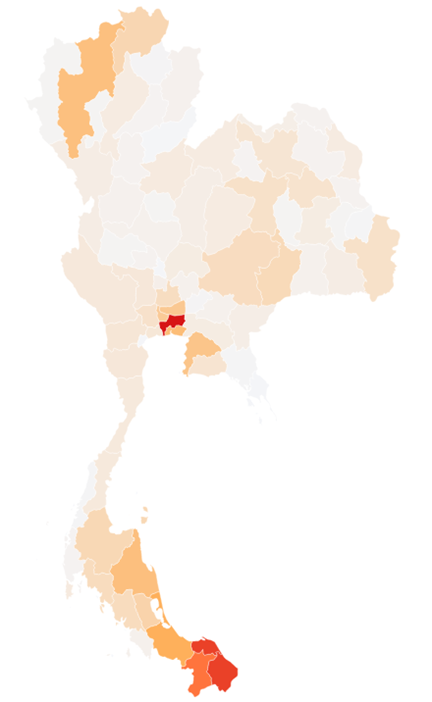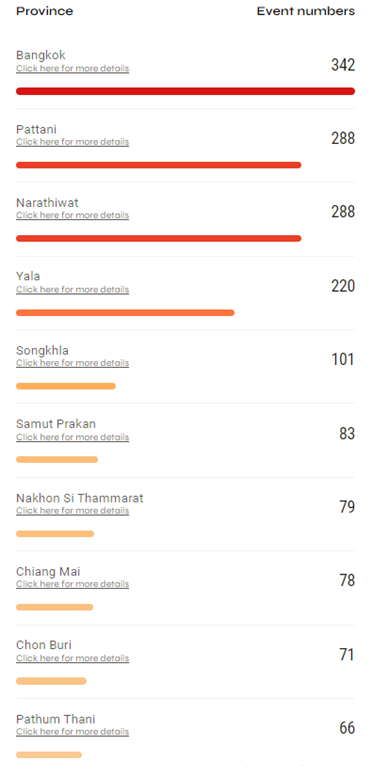MOVE Violence Database and Thai media
The media is frequently likened to a mirror, reflecting societal realities and representing public opinion. When it comes to the issue of prevalent violence; the media is seen as an institution that presents an accurate portrayal of violence in Thai society. However, from the perspective of political economy, the media is also an organization tasked with producing content that satisfies the demands of news consumers. This results in the “commodification” of violence; the media’s presentation of violent events becomes inherently tied to the process of framing compelling news content.
Certain violent incidents or those happening in specific regions of the country dominate the news, overshadowing others that do not capture public interest as much. In this study, we utilize data from the Monitoring Center on Organized Violence Events (MOVE)[2] to analyze media reporting of violent incidents. We examine the role of Thai mass media in truthfully reflecting these incidents, taking into consideration factors such as the location and working areas of the news agency. We also look at the practice of framing news content to make it more engaging, and how this impacts the portrayal of violence
.……………………………..
MOVE has curated a database detailing instance of organized violence in Thailand from 2016 to 2022. The data has been collected from daily reports on violence events published by five online news agencies: Bangkok Post, Khao Sod, Matichon, Thai Rath and Manager. The database categorizes violence incidents into 13 types and classified them according to parameters like frequency and type of violence, basic profiles of perpetrators and victims, along with the date, time, and locations of these occurrence. In assessing the source of information, we make two preliminary observations based on the political economy theoretical framework regarding the representative role of the media: Firstly, all five news organizations maintain their editorial offices in Bangkok or its surrounding areas. Given their geographic concentration, to what extent can these media organizations accurately represent violence occurring across the country? Secondly, in a competitive landscape, how do these media outlets select "products", or frame and publish news "agendas", to gain popularity in the consumer market? What kinds of violence are most likely to make the news/headlines? As media organization is also a business entity; as such, it operates with an aim to gain revenue from selling consumer products, and always with the expectation to maximize profit. (Hinwiman et al., 2015)
In considering geographic distribution, a review of the data and statistics in MOVE database reveals a higher incidence of violence in Bangkok and its surrounding areas compared to other regions. Excluding the four southern border provinces, which are considered as special cases, the number of incidents reported in Bangkok and its vicinity account for 21.4% of the total numbers of incidents reported across the country.

Figure 1: Map of provinces where 13 types of violent incidents occurred taken from MOVE database (1)

Figure 2: List of provinces with 13 types of violent incidents taken from MOVE database (2)
Examining the geographical locations of the editorial offices of the five media organizations that MOVE uses as sources of data, we find that they are all situated in the central region, specifically Bangkok and its surrounding areas. In the media business, the financial aspect of content production and profit are vital considerations. Reporting from locations beyond their immediate working zones incurs travel expenses. Costs are also associated with acquiring stock illustrations or hiring local journalists. These production expenses can result in the exclusion of violent incidents occurring in certain areas from the coverage of the central media agencies.
For instance, in examining the violence incidents in the four southern border provinces during November 2021, MOVE database recorded only five incidents. However, when compared with the Deep South Watch Database – an NGO independently collecting data and statistics on southern regional violence – 35 incidents were reported in the same period. The discrepancy between the two databases suggests that many violent events are not covered by the mainstream media. This indicates that the five central media agencies may have limited access to information from other regions or perform with a rather limited role in representing the truthful picture of the whole country. Thus, the reporting of violent incidents is not comprehensive, which can impact the representation of countrywide data and statistics.
A traditional media such as newspaper face stiff competition from a proliferation of news competitors, including online outlets, media organizations must prioritize certain types of content that can capture more attention.
Media organizations and news editors need to have news framing that is not only newsworthy but also captivates consumer attention through topics, content, illustrations, headlines and the use of sensationalization and dramatization (Ruamphum et al., 2021; Palau-Sampio, 2015) For instance, news regarding gender violence often garners substantial media coverage. This is consistent with the sexual violence statistics shown in MOVE, accounting for 23.1 percent of all recorded violence incidents. This observation invites further study: Is the extensive coverage of sexual violence news – a staggering one in five incidents captured by MOVE – a result of media agencies treating news as a highly valuable commodity? Additionally, the constraints of news framing might lead media agencies to simplify complex issues, reduce coverage of structural problems, and instead, focus on individual issues.
Conclusion and analysis
An examination of violence representation in the media and the role of Thai mass media in truthfully reflecting such incidents, as informed by MOVE data, indicates that central media entities continue to serve as the primary news representatives on a national level, yet their coverage does not extend comprehensively across the country. In light of this finding, we propose the following policy recommendations for consideration by relevant stakeholders:
- Encourage the enhancement of both skills and infrastructure among local news agencies and citizen media. This will foster a more representative news ecosystem for better portrayal of violence, contributing to a sustainable violence database.
- Support local and citizen media to develop their own databases, reducing dependence on mainstream media data.
- Provide support for research into violence, both physical and structural, thereby promoting more qualitative research into these critical issues."
References
Hinwiman, S., et al. (2015). Media business. [in Thai]. Thammasat University Press.
Palau-Sampio, D., (2015). Reference press metamorphosis in the digital context: clickbait and tabloid strategies in Elpais.com. Communication & Society, 29(2), 63-79.
Ruamphum, K., et al. (2021). Framing children's news in Thai newspapers and analyzing child ethics and children's rights issues. [in Thai]. An innovative distance learning e-journal. 11(2): July – December 2021. Retrieved from https://so01.tci-thaijo.org/index.php/e-jodil/article/view/241259
[1] Students of the Doctor of Communication Arts Program, Chulalongkorn University
[2] https://movedata.knowmorenomoreviolence.com/